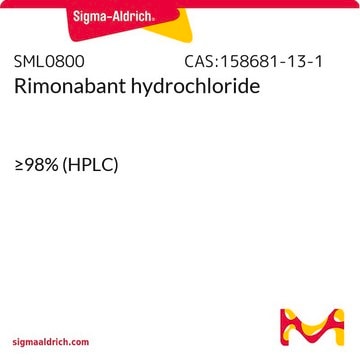344355
AS1842856
≥98% (HPLC), solid, Foxo1 inhibitor, Calbiochem®
Synonim(y):
Foxo1 Inhibitor, AS1842856, 5-Amino-7-(cyclohexylamino)-1-ethyl-6-fluoro-4-oxo-1,4-dihydroquinoline-3-carboxylic acid
About This Item
Polecane produkty
product name
Foxo1 Inhibitor, AS1842856, Foxo1 Inhibitor, AS1842856, is a cell-permeable inhibitor that blocks the transcription activity of Foxo1 (IC₅₀ = 33 nM). Directly binds to the active Foxo1, but not the Ser256-phosphorylated form.
Poziom jakości
Próba
≥98% (HPLC)
Postać
solid
producent / nazwa handlowa
Calbiochem®
warunki przechowywania
OK to freeze
protect from light
kolor
off-white to tan
tan to yellow
rozpuszczalność
DMSO: 5 mg/mL
Warunki transportu
ambient
temp. przechowywania
2-8°C
ciąg SMILES
O=C1C(C(O)=O)=CN(C2=C1C(N)=C(F)C(NC3CCCCC3)=C2)CC
Opis ogólny
Opakowanie
Ostrzeżenie
Rekonstytucja
Inne uwagi
Informacje prawne
Kod klasy składowania
11 - Combustible Solids
Klasa zagrożenia wodnego (WGK)
WGK 1
Temperatura zapłonu (°F)
Not applicable
Temperatura zapłonu (°C)
Not applicable
Certyfikaty analizy (CoA)
Poszukaj Certyfikaty analizy (CoA), wpisując numer partii/serii produktów. Numery serii i partii można znaleźć na etykiecie produktu po słowach „seria” lub „partia”.
Masz już ten produkt?
Dokumenty związane z niedawno zakupionymi produktami zostały zamieszczone w Bibliotece dokumentów.
Nasz zespół naukowców ma doświadczenie we wszystkich obszarach badań, w tym w naukach przyrodniczych, materiałoznawstwie, syntezie chemicznej, chromatografii, analityce i wielu innych dziedzinach.
Skontaktuj się z zespołem ds. pomocy technicznej








